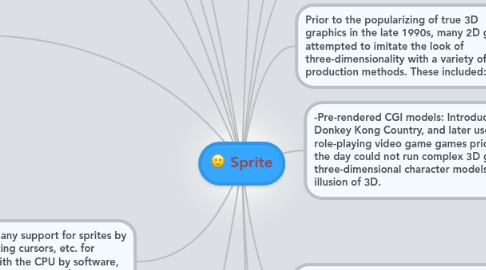Sprite
by Dhruv Gopal

1. In early video gaming, hardware sprites were a method of compositing separate bitmaps so that they appear to be part of a single image on a screen.
2. Many popular home computers of the 1980s lack any support for sprites by hardware. The animated characters, bullets, pointing cursors, etc. for videogames (mainly) were rendered exclusively with the CPU by software, as part of the screen video memory in itself. Hence the term software sprites.
3. evolution of a sprite
4. Gen 2
5. Gen 3
6. Gen 4
7. Gen 5
8. is a two-dimensional image or animation that is integrated into a larger scene
9. Initially including just graphical objects handled separately from the memory bitmap of a video display, this now includes various manners of graphical overlays.
10. -Many early graphics chips had true spriting use capabilities in which the sprite images were integrated into the screen, often with priority control with respect to the background graphics, at the time the video signal was being generated by the graphics chip.
11. this is an example of a sprite
12. Prior to the popularizing of true 3D graphics in the late 1990s, many 2D games attempted to imitate the look of three-dimensionality with a variety of sprite production methods. These included:
13. -Rotoscoping: The filmed performances of live actors were sometimes used for creating sprites, most famously in the case of Prince of Persia which added a relative element of realism to a platform game. The method was used in a number of other fighting games, mostly in the mid 1990s.
14. -Claymation or the use of posable models which were used for characters that could not be portrayed by actors. Famous early examples include Goro of Mortal Kombat and various enemies from Doom. Used to a greater extent in games like Clay Fighter and Neverhood.
15. -Pre-rendered CGI models: Introduced by Rise of the Robots and made famous by Donkey Kong Country, and later used to a great extent in PC real-time strategy and role-playing video game games prior to the move to real-time 3D. Since computers of the day could not run complex 3D graphics, footage of pre-rendered three-dimensional character models were often used which created a (relative) illusion of 3D.
